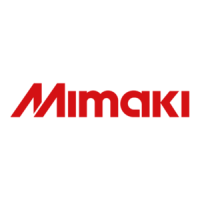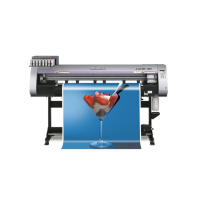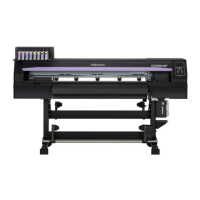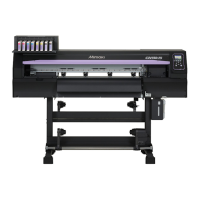Do you have a question about the MIMAKI CJV30-100 and is the answer not in the manual?
Covers fundamental operations like power ON/OFF, initial machine setup, media detection, and carriage functions.
Details on essential maintenance operations such as carriage out, wiper replacement, and ink system checks.
Explains the ink system configuration, cartridge control, and error monitoring for ink supply.
Information related to the print and cut functionalities of the machine.
Illustrates the overall electrical connections within the printer's main body and external units.
Explains the operational principles of the printer's print head carriage and its electronic components.
Details specifications for various circuit boards including power supply, main PCB, and others.
Procedures for replacing ink-related components like the head unit, cap, and cartridges.
Steps for replacing parts associated with the cut head carriage, including pen assembly and LED pointer.
Guides for replacing driving system components such as motors, belts, and encoder scales.
Procedures for replacing electrical components like the main PCB assembly.
Provides a matrix correlating operations with required adjustments for troubleshooting.
Details various adjustment functions like head alignment, media compensation, and motor current settings.
Instructions for mechanical adjustments such as sensor positioning and roller alignment.
Covers various test functions for checking patterns, motors, sensors, and other operations.
Includes tests for COM short circuit, PCB integrity, and FFC line conduction.
Details on removing and installing various covers of the printer.
Procedures for disassembling and reassembling ink system components like head units and pumps.
Instructions for disassembling and reassembling the cut head carriage and its parts.
Disassembly and reassembly procedures for drive system components such as motors and belts.
Guidance on disassembling and reassembling electrical components and PCBs.
Details on sensor layout and identification for troubleshooting.
Covers general troubleshooting steps, error messages, and warning messages.
Provides detailed solutions for specific malfunctions like belt noise, media issues, and electrical problems.
A checklist for diagnosing PCB damage and recording troubleshooting steps.
Describes basic operations like starting the machine, initial filling, and media detection.
Details on print modes including LOCAL/REMOTE, SETUP, and MAINTENANCE procedures.
Explains operation flows for cut modes, including LOCAL/REMOTE and SETUP configurations.
Covers common settings such as fan control, media handling, and system parameter configurations.
Details service mode functions like #ADJUST, #TEST, and #PARAMETER adjustments.
Covers fundamental operations like power ON/OFF, initial machine setup, media detection, and carriage functions.
Details on essential maintenance operations such as carriage out, wiper replacement, and ink system checks.
Explains the ink system configuration, cartridge control, and error monitoring for ink supply.
Information related to the print and cut functionalities of the machine.
Illustrates the overall electrical connections within the printer's main body and external units.
Explains the operational principles of the printer's print head carriage and its electronic components.
Details specifications for various circuit boards including power supply, main PCB, and others.
Procedures for replacing ink-related components like the head unit, cap, and cartridges.
Steps for replacing parts associated with the cut head carriage, including pen assembly and LED pointer.
Guides for replacing driving system components such as motors, belts, and encoder scales.
Procedures for replacing electrical components like the main PCB assembly.
Provides a matrix correlating operations with required adjustments for troubleshooting.
Details various adjustment functions like head alignment, media compensation, and motor current settings.
Instructions for mechanical adjustments such as sensor positioning and roller alignment.
Covers various test functions for checking patterns, motors, sensors, and other operations.
Includes tests for COM short circuit, PCB integrity, and FFC line conduction.
Details on removing and installing various covers of the printer.
Procedures for disassembling and reassembling ink system components like head units and pumps.
Instructions for disassembling and reassembling the cut head carriage and its parts.
Disassembly and reassembly procedures for drive system components such as motors and belts.
Guidance on disassembling and reassembling electrical components and PCBs.
Details on sensor layout and identification for troubleshooting.
Covers general troubleshooting steps, error messages, and warning messages.
Provides detailed solutions for specific malfunctions like belt noise, media issues, and electrical problems.
A checklist for diagnosing PCB damage and recording troubleshooting steps.
Describes basic operations like starting the machine, initial filling, and media detection.
Details on print modes including LOCAL/REMOTE, SETUP, and MAINTENANCE procedures.
Explains operation flows for cut modes, including LOCAL/REMOTE and SETUP configurations.
Covers common settings such as fan control, media handling, and system parameter configurations.
Details service mode functions like #ADJUST, #TEST, and #PARAMETER adjustments.
| Ink Type | Solvent ink |
|---|---|
| Number of Print Heads | 2 |
| Connectivity | USB 2.0, Ethernet |
| Print Technology | Inkjet |
| Max Resolution | 1440 x 1440 dpi |
| Print Resolution | 1440 x 1440 dpi |
| Ink Colors | C, M, Y, K |
| Media Thickness | Up to 1.0 mm (0.04") |
| Media Types | Vinyl, banner, paper |
| Media Handling | Roll feed |
| Cutter Type | Integrated |
| Weight | 150 kg |











